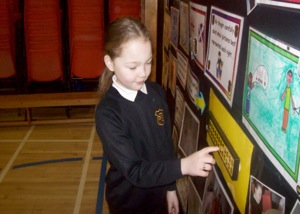Background
Talk time kit borrowed for use at art exhibition, which was to be set up in the local church hall. Parents/Carers invited to daffodil tea and to view art exhibition. Children also made bits to sell (enterprise) and talk time points used for children to record the price of their goods.
How ICT supported learning and teaching
The nursery children were unable to man the stalls due to health and safety in the hall. The talk time points meant the children were still involved in the ‘selling’ as it was their voices stating the cost of the goods. P7 children took responsibility on the stalls. Parents loved to hear the children’s voices by pressing the equipment. Due to the number of pieces of artwork displayed (100) I did manage to use the boards as I had planned. Also concerned the hall would be too noisy – it was! I would have used these back at the nursery this week if I had not had to return the equipment.
Impact/ Conclusion
Now that I have used this equipment and realised how easy it is to use I would use it again and can see the countless ways it would work in the nursery setting. I would suggest we buy talking points to reinforce key instructions in areas of the nursery – e.g. 4 children only at the sand tray. Also the board. The parents and children loved the results and I feel I only just started. Could take this a lot further.
Nicola Coleman







